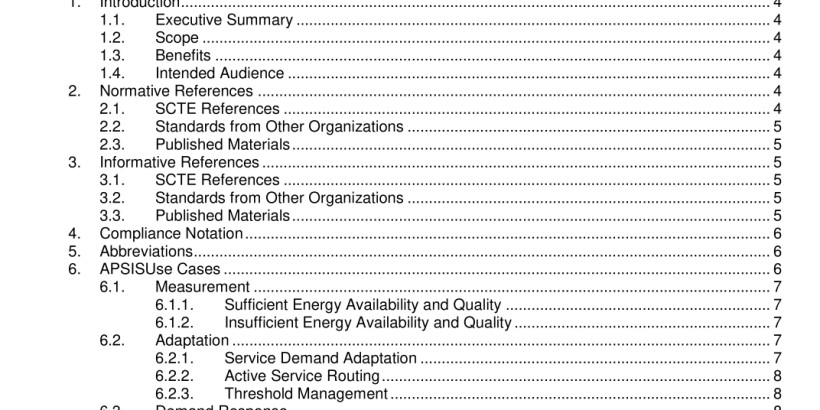ANSI SCTE 245-2018 pdf download.Use Cases for Adaptive Power Using APSIS
1.2. Scope
This document describes use cases as relevant for cable system operators, with specific focus on the cable access network; the infrastructure that delivers services between a content source such as a data center, and a subscriber. SCTE 216, which normatively references IETF EMAN and related RFCs, is generalized to be relevant to domains outside the scope of the cable access network and to support use cases not de-scribed here. Further development in this field may lead to discovery of technical and business opportunities not anticipated here. For these reasons, the use cases presented here should not be considered exhaustive. These use cases are merely descriptive of the potential applicability of APSIS. Any specific use case may or may not be adopted by any set of system operators. The presentation of a use cases should not be construed to indicate that it will be implemented by a specific system operator.
1.3. Benefits
This document provides insight into the intended use cases addressed by SCTE 216 and 237, and provides illustration to operators, vendors, and energy management application developers about possible areas of development within the industry.
1.4. Intended Audience
This document is intended to be referenced by business and technical teams within cable operator, vendor, and application development organizations.
2. Normative References
The following documents contain provisions, which, through reference in this text, constitute provisions of this document. At the time of Subcommittee approval, the editions indicated were valid. All documents are subject to revision; and while parties to any agreement based on this document are encouraged to investigate the possibility of applying the most recent editions of the documents listed below, they are reminded that newer editions of those documents might not be compatible with the referenced version.
4. Compliance Notation
shall This word or the adjective “required” means that the item is an absolute requirement of this document. shall not This phrase means that the item is an absolute prohibition of this document. forbidden This word means the value specified shall never be used. should This word or the adjective “recommended” means that there may exist valid reasons in particular circumstances to ignore this item, but the full implications should be understood and the case carefully weighted before choosing a different course. should not This phrase means that there may exist valid reasons in particular circumstances when the listed behavior is acceptable or even useful, but the full implications should be understood and the case carefully weighed before implementing any behavior described with this label. may This word or the adjective “optional” means that this item is truly optional. One vendor may choose to include the item because a particular marketplace requires it or because it enhances the product, for example; another vendor may omit the same item. deprecated Use is permissible for legacy purposes only. Deprecated features may be removed from future versions of this document. Implementations should avoid use of deprecated features.
6.1.1. Sufficient Energy
Availability and Quality There exits sufficient energy supply, with acceptable quality such that no services are being impacted due to energy reasons. Such measurements provide a baseline for normal system operations and may be incorporated into calculations of approximate energy usage across the organization, i.e. annual greenhouse gas (GHG) emissions.
6.1.2. Insufficient Energy
Availability and Quality In cases where power becomes wholly unavailable, e.g. grid power outage, or power quality is degraded to such degree to impact some aspect of service delivery, a measurement system may be used to detect and potentially aid response to such conditions. Information about power availability and quality may also be valuable to external parties, such as utilities, regulators, and researchers.
6.2. Adaptation
Adaptation refers to active optimization to improve energy efficiency – it is the equivalent of turning off lights in your house when they’re not needed. An adaptive energy system optimizes energy usage in response to changing conditions. Resources that are not necessary to delivery service at a point in time are put in sleep mode or low power state. It is imperative that an adaptive system be sophisticated enough to manage energy usage without impacting the customer experience or other critical aspects of service delivery.ANSI SCTE 245-2018 pdf download
